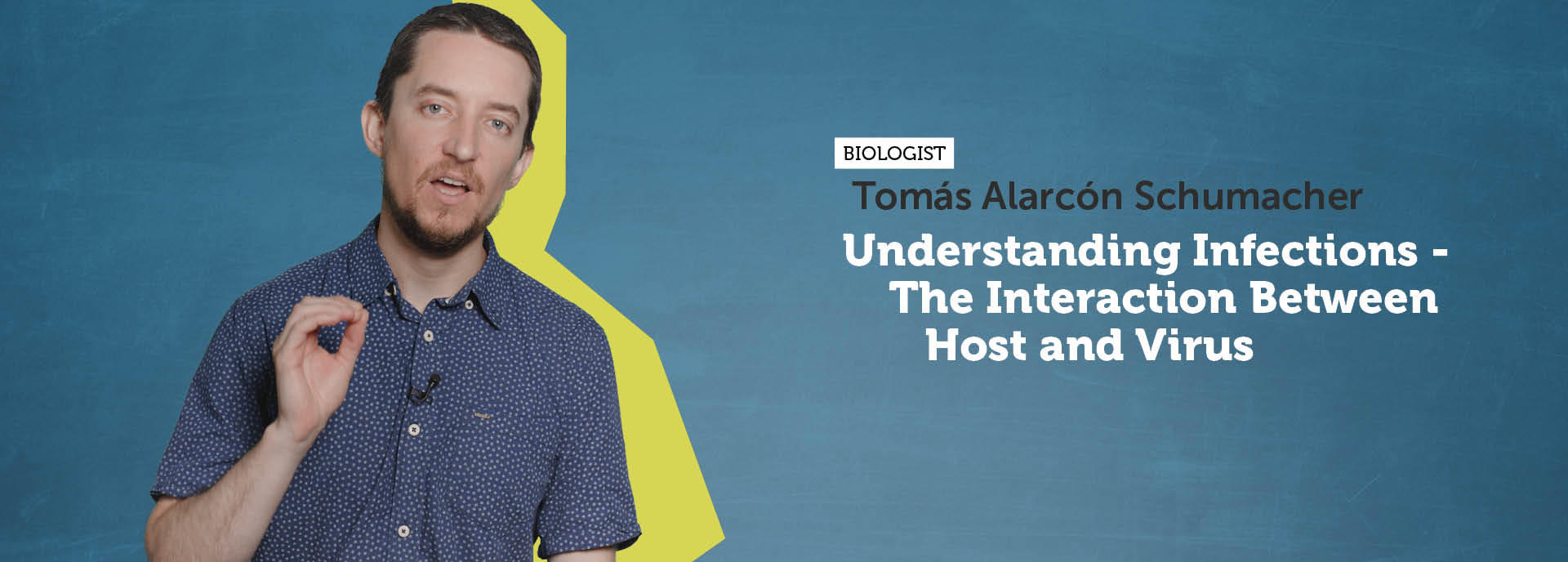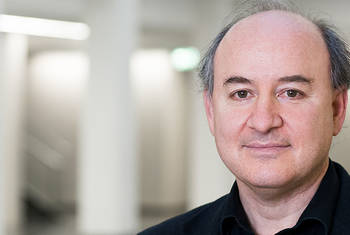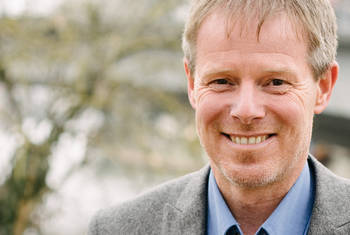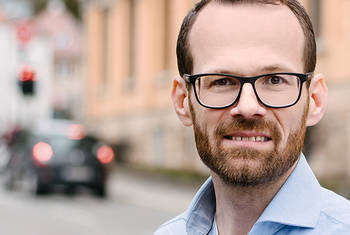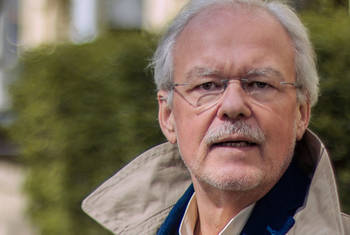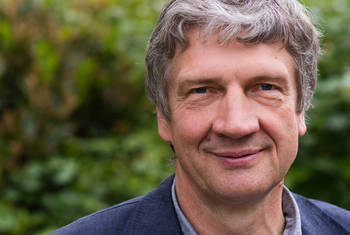Global warming means that mankind needs to find ways to remove carbon from the atmosphere. In this video, SILVIA VIDAL MELGOSA highlights the fact that microalgae remove as much carbon as all plants on land and considers what we can learn from these natural processes. Collecting samples during a three month microalgae bloom in the North Sea, Vidal Melgosa underlines the fascinating role played by the polysaccharide [...] Watch video
Sea grasses play an important role in the global carbon cycle. In this video, SINA SCHORN investigates the mechanisms by which the Mediterranean sea grass Posidonia oceanica stores carbon while emitting methane. Employing methods including flex measurements and substrate addition experiments, among Schorn’s most important findings is the fact that sediments in which sea grasses have died off can continue to emit methane [...] Watch video
Vital steps have been taken in recent years in our understanding of how the cerebral cortex functions at the cellular level. In this video, MATTHEW LARKUM analyzes the role that memory plays in this context. Employing techniques including electrical and optical recordings as well as chemogenetics in experiments with live animals, Larkum’s lab has demonstrated that the medial temporal lobe projects to layer one of the [...] Watch video
Which Evolutionary Changes in the Genome Led to the Development of the Large-Sized Human Brain?
During the evolution of primates their brain size, and specifically the size of their cerebral cortex where the higher cognitive functions are located, expanded. Stem cells in the human brain go through a higher number of cell divisions and thus produce a higher number of neurons then do stem cells in the brains of apes. The research presented in this video investigates which evolutionary changes in the genome caused this [...] Watch video
The ability to process complex syntax is a human characteristic. The development of language comprehension and articulation takes place over a certain period of time during childhood. What happens in the brain on a neural biological level during language acquisition is still unclear. The research explained in this video uses methods that detect and monitor brain activity to determine changes and patterns on the scale of [...] Watch video
RÜDIGER KLEIN and his research group are interested in the question of how newly born cells, so-called neurons, communicate with other cells during embryonic development and how this communication shapes the brain. During development, neurons explore their environment for the presence of chemical signals. One family of such chemical signals are called FLRTs. It is assumed that these FLRT proteins tell the neurons in [...] Watch video
Each nerve cell in mammalian brains communicates with about a thousand other nerve cells. This creates a communication network that is likely one of the most complex networks that we know of. Understanding the rules by which this network is created and by which it operates is one of the current questions in neuroscience. MORITZ HELMSTAEDTER studies this connectivity and he is particularly interested in how the cerebral [...] Watch video
When memorable experiences occur, a particular subset of neurons is activated in the brain. In this video, ALESSIO ATTARDO analyzes how these engram neurons are created. Imaging the synapse network through which neurons connect and communicate, Attardo is able to identify distinctions between those that go on to become engram neurons and those which do not. Focusing on the hippocampus, this work calls into question [...] Watch video
The technique of Magnetic Resonance Imaging, or short MRI, is a useful and widely used tool in clinical diagnostics. However, the current MRI techniques are not sensitive enough to detect low concentrations of drugs or disease related molecules. LEIF SCHRÖDER explains that MRI is typically based on the detection of water molecules. However, the high water concentration that is always present in the body creates a strong [...] Watch video
Multicellular organisms first took their place in the evolutionary chain some 450 million years ago. In this video, THOMAS BOSCH seeks to extend our understanding of how human and animal bodies function via analysis of these ancient creatures. Focusing on the freshwater polyp Hydra and employing techniques including molecular cell biology, modern sequencing technology and in depth study of stem cell behavior, Bosch argues [...] Watch video
The human brain has many functions; for instance, it allows people to focus on particular objects and ignore others, or to remember events in the past. TATJANA TCHUMATCHENKO uses mathematical equations in order to understand how our brain achieves this. Previous research in this area has developed models that explain single questions, such as ‘How does memory work?’. However, as she describes in this video, the brain [...] Watch video
How Can Functional Magnetic Resonance Imaging Help Detect, Visualize, and Treat Strokes?
Stroke is one of the most frequent neurological disorders, befalling over 250.000 persons each year in Germany alone. The research underlying this video explores the role of non-invasive methods for stroke diagnosis and therapy. The use of functional Magnetic Resonance Imaging (fMRI), which produces image-signals on the basis of the oxygen-concentration in the blood, allows for the detection of increased or decreased [...] Watch video
Our memories define who we are. Here, learning and memory are essential but how does the brain process and store information? Neurons are the elemental cells that compute and store this information in several ways. ALESSIO ATTARDO is interested in synapses. Synapses are the connections between neurons and this is where information flows. Specifically, Attardo focuses on the basic principles that govern synaptic plasticity [...] Watch video
How Do Behavioral Context and Internal State Influence Sensory Perception and Behavior?
Behavior is flexible and we can adapt it according to certain needs or particular contexts. ILONA GRUNWALD KADOW and her team are interested in the underlying neural mechanisms in the brain and also the genes that allow us to exhibit flexible behavior. As Grunwald Kadow explains in this video, they used fruit flies (Drosophila melanogaster) and genetic methods in their experiments. Their findings suggest that internal [...] Watch video
The gut microbiome has a significant influence on various diseases ranging from malnutrition to chronic inflammation. It is largely shaped by environmental factors, like diet and lifestyle. How the genetics of the individual affect the composition of the microbiome, however, was largely unknown. RUTH LEY explains in this video that the research team addressed this question by comparing the microbiome of over 1000 twin [...] Watch video
Can Biosignatures Be Used to Develop a Reliable, Fast and Low-Cost Test for Tuberculosis?
Tuberculosis is still a major health issue and the number one killer of all contagious diseases. But while more than 2 billion people are infected with the tuberculosis agent, only 10% develop an active disease. Current diagnostic tests cannot distinguish between infected people and people with active tuberculosis. In this video, STEFAN H. E. KAUFMANN explains that they found a characteristic gene expression profile of [...] Watch video
What Mechanisms Underlie the Interaction Between a Virus and its Host During an Infection?
Traditionally, viruses have been viewed as little more than killing machines. In this video, TOMÁS ALARCÓN SCHUMACHER shows how certain viral infections can have a positive effect on their hosts’ evolutionary trajectories. Focusing on chronic infections in archaeal bacteria, Schumacher employs techniques including quantitative PCR, RNA sequencing and proteomics. Among his more striking findings are that the virus can [...] Watch video
One the most common types of leukemia is chronic lymphocytic leukemia. To find the right treatment for an individual patient with that disease is a challenging task and many patients develop a resistance against the existing drugs. The purpose of the research presented by BRIGITTE VOIT in this video is to find new drugs that reduce cancer cells while not destroying other cells in the body. The researchers created two [...] Watch video
Our immune system has evolved many different cells with different functions to prevent infections. One of these functions is cellular cytotoxicity; this means that cells are able to kill other cells. Natural killer cells (NK cells) are one type of these cells that can achieve cytotoxicity. CARSTEN WATZL experiments with NK cells in order to find out how they protect themselves from their own cytotoxic machinery and how [...] Watch video
Unlike other human infectious diseases (e.g. tuberculosis, HIV), malaria is transmitted between humans via mosquitoes. In this video, ELENA LEVASHINA analyzes the mechanisms of how mosquitoes transmit malaria. Combining population studies conducted in the field with mathematical approaches, Levashina finds that mosquitoes with particular genetic characteristics transmit malaria more effectively than others. Though further [...] Watch video
The next pandemic seems likely to result from a bacterial pathogen. In this video, ANDREAS PESCHEL explores how we can effectively fight bacterial pathogens, especially where they are resistant to antibiotics. Adopting an interdisciplinary approach with colleagues from computational, clinical and compound focused sciences, Peschel’s research focuses on the bacteria Staphylococcus aureus commonly found in the human nose. [...] Watch video
Which Antigenic Determinants Can Be Used for Therapeutic Vaccinations Against HPV-Mediated Cancer?
The research presented in this interview pursues the goal of developing a therapeutic vaccine against cancer induced by human papillomavirus (HPV). As ANGELIKA RIEMER explains, the project identified T helper epitopes to enhance existing vaccines and led to the identification of five valuable candidates for inclusion into a therapeutic HPV vaccine. This was accomplished via a computer-based analysis of already existing [...] Watch video
Which Functions Do the Noncoding Parts of Human RNA Have in Metastasis Formation of Lung Cancer Cells?
Parts of the human RNA that are not translated into proteins may still have an important function. As SVEN DIEDERICHS explains in this video, the occurrence of the RNA gene Malat-1 makes the difference between lung cancer with and without metastasis. By first identifying Malat-1 as the molecular difference between patients and then silencing this RNA gene, it was found that Malat-1 could be a viable target to suppress [...] Watch video
T cells are an important component of the body’s immune system. As ERIKA PEARCE explains, there are several types of T cells which form consecutively during the immune response and serve different purposes. Effector T cells combat pathogens from infections or tumors while memory T cells provide protective immunity to prevent re-infection or reoccurring cancer. The research presented in this video investigates how the [...] Watch video
Neutrophils are both the most abundant immune cells and the first to go to a site of infection. In this video, ARTURO ZYCHLINSKY explores the role that Neutrophils play in infectious disease. Zychlinsky explains that Neutrophil Extracellular Traps (or NETs) kill and prevent the dissemination of microbes while also alerting other parts of the immune system to infection. Revealing some of the processes involved in NET [...] Watch video
All cells in our bodies contain the same genetic information. Yet, these cells make up very different parts of the body like liver, heart, and eyes. This is achieved by expressing certain genes and inactivating others. The protein MOF is known to play an important role in this process: DNA does not flow freely in the cell nucleus but is packaged by histone proteins. There, MOF facilitates reading the genetic information [...] Watch video
The research presented in the video investigates how endosomes are able to transport material back to the cell surface in a process called recycling or endosomal exocytosis. In order to do so, endosomes have to have their own identity which is defined by a phosphoinositide, Phosphatidylinositol 3-phosphate (PI3P). To deliver the material to the cell surface the endosomes have to get [...] Watch video
Do New Genes Stem From the Non-Coding Part of the Genome During Fast Adaptation Processes?
It is often thought that evolution is a slow process. During ecological changes in the environment, however, evolution can happen very fast. One of the reasons for this could be the role of new genes that are recruited during that adaptation. DIETHARD TAUTZ pursues the theory that these new genes come out of the so-called non-coding part of the genome. He is interested in studying the fraction of bioactive molecules that [...] Watch video
Our genes only make up about one or two percent of the human genome; the rest of the genome contains other functions including how the genes get activated. In current understanding, this regulation of the genes contains the key to the complexity of human development. Many parts of the human genome, not only the genes, get transcribed and the function of these thousands of transcripts is not yet understood. This is a [...] Watch video
Proteins mediate a vast array of functions in the body, like fighting invaders or transporting oxygen. Their remarkable properties are due to their three-dimensional structure which is acquired by a simple chain of molecules, a polypeptide, folding into a complex structure, the protein. This folding process is still not fully understood and hence also difficult to replicate in a laboratory. To learn more about how it [...] Watch video
Why are some people more prone to sickness than others? Individual people differ in their genetic predisposition to disease. TOBIAS LENZ and his research group investigate whether historical selection by pathogens – by infectious agents – has shaped the genetic makeup of our immune system today. Their specific focus here is on whether selection by pathogens on specific immune genes, so-called HLA genes, has affected [...] Watch video
Different ethnic groups have shaped the genetic makeup of today’s Europeans. Through migration from various regions of the world, the genetic material of humans who first arrived in Europe forty thousand years ago has seen drastic changes over the last ten thousand years. By analyzing D.N.A extracted from ancient bones, JOHANNES KRAUSE traces back the genetic ancestry of human beings, especially those living in Europe [...] Watch video
Humans may be sharing earth with up to twenty million species of macroscopic life, let alone microscopic life. Today, about 1.8 million species have been described and currently, we discover about 18,000 species per year, which means it would take us thousands of years to describe them all. This is why JOHANNES VOGEL endeavors to increase the current rate of discovery dramatically, as he explains in this video. [...] Watch video
How Does the Interplay of Genes, Environment, and Development Affect the Biological Diversity of a Species?
Plants, animals, and fungi show a huge diversity regarding form and phenotype: the observable characteristics of an organism. The research presented in this video uses the model of a particular roundworm to investigate how the phenotype is changed by the environment; this is known as phenotypic plasticity. RALF SOMMER explains that Pristionchus pacificus develops alternative mouth forms depending on their environment, [...] Watch video
How does sexual selection contribute to biodiversity on earth? ASTRID T. GROOT investigates this question using the example of moths. As she explains in this video, in many species, including moths, the most common individuals are chosen as mates and the ones that deviate away from the mean are selected against. Following this principle, you would expect less and less variation but this is not the case. Thus, her research [...] Watch video
Migratory birds can travel thousands of kilometers with great precision. In this video, MIRIAM LIEDVOGEL explores the genetic characteristics that enable this. Focusing on blackcaps because of the different types of migratory behavior that they exhibit, Liedvogel employs geolocator technology to track birds’ movements in their natural habitat. Among other things, the research demonstrates that differing migratory [...] Watch video
Humans pride themselves on having extensive and diverse cultures. However, cultures can also be observed in animals. The research presented in this video aims at understanding the cultures of wild chimpanzee populations in several African countries and how they differ from each other. As chimpanzees avoid human contact, CHRISTOPHE BOESCH explains, the research team conducted the study by setting up camera traps to catch [...] Watch video
When researchers want to delve deeper into the brain mechanisms of speech patterns, they cannot do all experiments on human subjects. This is why STEFFEN R. HAGE studies the vocalizations of marmoset monkeys. Particularly, as he explains in this video, he is interested in the long sounds these monkeys produce with durations up to three or four seconds. There is a debate whether these long sounds are produced out of [...] Watch video
By combining behavioral observations with GPS data on the whereabouts and data on genetic relatedness of males of a Guinea baboon population, the study presented in this video provides new insights into their social structure: The species forms structured multi-level societies. Male Guinea baboons are found to be exceptional in terms of their spatial tolerance and their organizing principle, JULIA FISCHER explains. As [...] Watch video
Looking at bones, joints or muscles, their function is not necessarily clear from their form. MARTIN S. FISCHER’s overarching research interest has always been the integration of form and function and the function of motion. In this video, he explains how locomotion, how animals and humans move, influences all locomotor operators. To examine the function of form the researchers need to study form during motion. For [...] Watch video
The accumulation of carbon dioxide (CO2) in the Earth’s atmosphere is responsible for one of the most pressing problems of our age, global warming. In this video, SUSAN TRUMBORE analyses the key role that plant and soil systems play in the carbon cycle in order to better understand how they can assist us in combating this issue. Trumbore explains how Carbon-14 (or radiocarbon), a byproduct of atmospheric weapons testing [...] Watch video
How Do Belowground Components Contribute to the Healthy Functioning of Ecological Systems?
Being easier to observe, the aboveground components of ecological systems tend to be considered of predominant importance. In this video, STEFAN SCHEU explains the extent to which the healthy functioning of these systems is dependent on what happens underground. With visual observation impossible, Scheu employs isotope labeling to trace the paths taken by particular elements belowground. Where it was heretofore understood [...] Watch video
The study presented in this video evaluates data from observational towers, satellite pictures and other published data to compare the impact of land-cover change and land management change on climate. The results show that land management change within the same vegetation (e.g., harvesting a formerly untouched forest) has effects on climate change that are similarly large as effects of land-cover change (e.g., changing [...] Watch video
The ability to cooperate with each other has given humans one of the key advantages in the colonization of this planet. What about other species? Do they have cooperative abilities as well? RUSSELL GRAY and his fellow researchers have investigated this particular question observing keas, a New Zealand bird known for its playfulness and inquisitiveness. The researchers designed three experimental set-ups that tested the [...] Watch video
It has been known since the 1980s that sugars are central to the growth of plants. High levels of carbohydrates enable the plant to assimilate nitrogen to increase amino acid synthesis which then enables them to make proteins more quickly which, in turn, allows the plant to grow faster. It is still unclear, however, how plants sense their levels of carbohydrates and how they regulate their metabolism and growth based on [...] Watch video
Streptococcus pneumoniae kills millions of people worldwide. For the subgroup serotype 8, prevalent in the United States and Western Europe, there is no vaccine to date. In this video, PETER H. SEEBERGER explains the approach of his research group to create a synthetic sugar vaccine against this bacterial infection that works in mice. They relied on synthetic chemistry to assemble sugar chains from monomers; the [...] Watch video
How Does the Interaction of Water with Collagen Lead to Pretension in Our Connective Tissues?
The connective tissues in our body – such as skin, tendon, or bones – all contain a molecule called collagen. When you cut your skin, it springs open. This shows that the tissues in our body are under pretension. The research presented in this video is interested in the question of whether the interaction of collagen with water causes this tension. The researchers found, as PETER FRATZL explains, that the pretension [...] Watch video
How Can We Improve the Existing Vaccine for Tuberculosis to Combat the Growing Number of Multi-Resistant Strains?
Each year 1.5 million people die of tuberculosis thus making it the number one killer of all contagious diseases. With the number of multi-resistant tuberculosis growing, currently available treatments are no longer as effective as they used to be. The existing vaccine does not protect against pulmonary tuberculosis which is the most common form of the disease and easily transmittable. In this video, STEFAN H. E. KAUFMANN [...] Watch video
Almost everybody has to deal with stress sometimes. But what is stress? It is a reaction of the body to a challenging situation which elicits a stress response in the body. Stress is also a risk factor for disease and this is an area that MATHIAS V. SCHMIDT and his research team focus on. The most prominent stress-related disorders are psychiatric disorders and metabolic disorders. Specifically, as Schmidt explains in [...] Watch video
How Is Cross-Talk Between Calcium and Actin Cytoskeleton Involved in Memory Formation?
How are memories formed and stored in the human brain? This is the overarching question that leads MARINA MIKHAYLOVA’s research. As she explains, there are two important features of memory formation: plasticity and stability of dendritic spines, small protrusions where synapses are formed. Activity-dependent remodeling of the actin cytoskeleton in dendritic spines is essential for synaptic plasticity. This process is [...] Watch video
Insects are very smell-dependent which makes them prime candidates for studying how the sense of smell works and how it influences behavior. In this video, BILL S. HANSSON describes how the research team studied the olfactory system of flies. Following the whole process from molecule detection and the reaction of the nerves to the outcome of behavior the researchers found a line in the fly's brain that identifies bad [...] Watch video
How Does the Molecular Machine That Drives Energy Conversion in the Cell Membrane Work?
Cells need to convert the energy derived from food to perform functions like muscle contractions. A “molecular machine” in the cell membrane plays a key role in this process. It works like a rotor and converts one component into another. In this video WERNER KÜHLBRANDT describes how the scientists used state-of-the-art electron microscopy to study the structure of this nanometer turbine down to the atomic level. The [...] Watch video
Organic mass in the surface ocean is made up of 50% polysaccharides which are consumed by bacteria. In this video, GRETA GILJAN examines how bacterial consumption of polysaccharides takes place as well as its carbon impact. Giljan employs fluorescently labeled polysaccharides (FLA-PS) to show how different bacteria use variant methods to take up polysaccharides at particular times of year. The research further [...] Watch video
What Is The Relationship Between Sea Grasses And The Microbial Communities That Live In Their Sediments?
Seagrasses evolved from terrestrial plants on at least 3 separate occasions. We know that land plants interact with their microbial communities in their soils to recruit symbionts. In this video, EMILIA SOGIN investigates whether seagrasses also retained their interactions with the microbial communities that live in their sediments. Conducting metabolomic analyses of sediment porewater as well as incubation experiments [...] Watch video
When bacteria are used to reduce industrial CO2 emissions via biological gas conversion, the presence of carbon monoxide (CO) causes problems because it is toxic to nearly all organisms. In this video, OLIVIER LEMAIRE explains how a subgroup of acetogenic bacteria directly uses CO to produce acetate. Lemaire analyzes Clostridium autoethanogenum and identifies two key proteins, (CO dehydrogenase and acetyl-CoA synthase) [...] Watch video
Daylength on Earth has increased very gradually from something like 4-12 hours 4.5 billion year ago to 24 hours at present. In this video, JUDITH KLATT explores whether the emergence of oxygen on our planet, vital to the evolution of life, can be linked to changes in the Earth’s rotation rate (daylength). Klatt’s study focuses on the release of oxygen from microbial mats. Modeling and testing in the Middle Island [...] Watch video
Massive algae blooms appear in spring in certain bodies of water only to vanish within a number of weeks. In this video, BERNHARD M. FUCHS analyzes the degradation of such algae, exploring which organisms are involved and what they actually do. Employing methodologies involving ribosomal RNA, in situ hybridization and metagenome sequencing, Fuchs finds that a strikingly limited range of organisms (Flavobacteria) are [...] Watch video
What happens in the marine nitrogen cycle? In this video, KATHARINA KITZINGER explains that nitrification as carried out by marine microorganisms involves two distinct processes, with ammonia oxidation resulting in nitrite which is then transformed to nitrate via nitrite oxidation. Using stable isotopes to assess the abundance and activity of the microorganisms that catalyze these two processes, Kitzinger observes that [...] Watch video
What New Insights into Plants' Defense Mechanisms Can Be Gained by Studying Their Interactions with Their Habitat?
In the past decades plants were viewed primarily as “growth machines” that produce oxygen and biomaterials. The research projects presented in this video look at plants more as organisms that have to solve the challenges of life. The studies analyzed the reaction of plants to certain ecological interactions in a manner that brings together molecular biology and ecology. This reunion of biological sub-disciplines [...] Watch video
Why and How Do Plants Emit Volatile Compounds When Defending Themselves Against Herbivores?
Plants have at least two ways of defending themselves against herbivores. They can do so directly by producing toxins or compounds that are anti-digestive, or they can indirectly defend themselves by emitting volatile compounds that attract predators and parasitoids of the herbivores. MEREDITH SCHUMANN investigates these indirect defenses. As she explains in this video, there are both fast and slow components to [...] Watch video
How Do Forest Trees Defend Themselves Against Insects Under Natural Conditions and Is This Process Affected by Forest Management?
When plants are being attacked by herbivore insects, they protect themselves by emitting volatiles that attract enemies of the insects. This has already been well investigated in greenhouse settings and on smaller plants but very little research has been done under natural conditions and on trees. In this video, SYBILLE UNSICKER explains how the research team studied this pattern in the forest ecosystem while also [...] Watch video
Once a plant has germinated in a particular location, it cannot change it anymore. This means its growth depends on its location with its particular context, such as soil, herbivores, or sunlight levels. Therefore plants have evolved sophisticated signal transduction systems that allow them to perceive the outside world and then modify their growth, morphology and chemicals production and develop different phenotypes. IAN [...] Watch video



